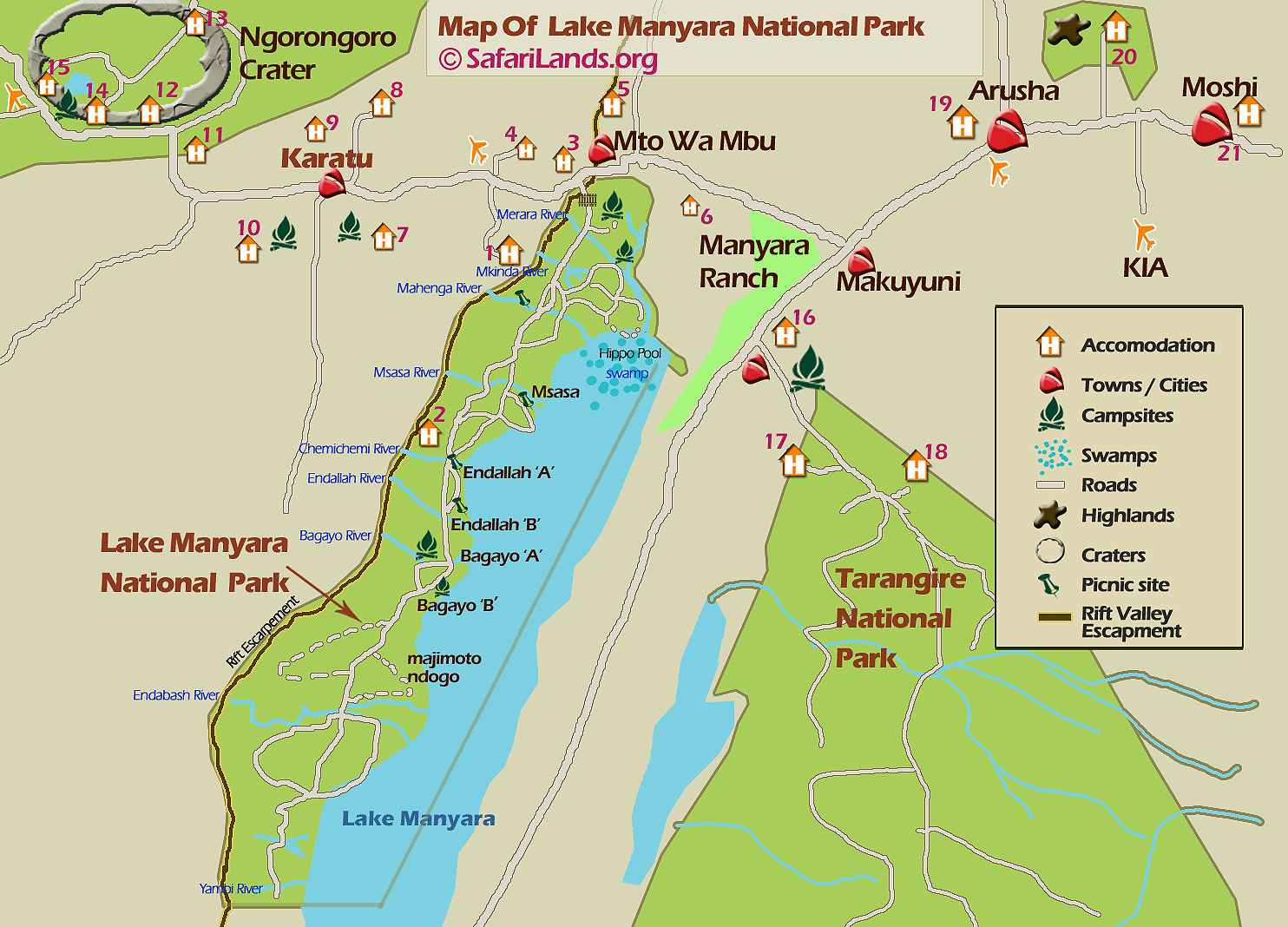

Lake Manyara N. Park –Size: 330 km² / 130 mi² –Altitude-953-1445 m / 3127-4741 ft
Lake Manyara NP is a small park at the base of the Rift Valley escarpment. Its groundwater forest offers a nice change of scenery from the more savannah dominated parks. Although the park is known for tree-climbing lions, big cats aren’t that easily seen. Elephants are very prolific and are the main attraction.
Location: In northern Tanzania. The entrance gate lies 1.5 hours (126km/80 miles) west of Arusha along a newly surfaced road, close to the ethnically diverse market town of Mto wa Mbu. Stretching for 50km along the base of the rusty-gold 600-metre high Rift Valley escarpment, Lake Manyara is a scenic gem, with a setting extolled by Ernest Hemingway as “the loveliest I had seen in Africa”. The compact game-viewing circuit through Manyara offers a virtual microcosm of the Tanzanian safari experience.

From the entrance gate, the road winds through an expanse of lush jungle-like groundwater forest where hundred-strong baboon troops lounge nonchalantly along the roadside, blue monkeys scamper nimbly between the ancient mahogany trees, dainty Bush-buck tread warily through the shadows, and out sized forest horn-bills honk cacophonous in the high canopy.

Contrasting with the intimacy of the forest is the grassy floodplain and its expansive views eastward, across the alkaline lake, to the jagged blue volcanic peaks that rise from the endless Maasai Steppes. Large buffalo, wildebeest and zebra herds congregate on these grassy plains, as do giraffes – some so dark in coloration that they appear to be black from a distance. Inland of the floodplain, a narrow belt of acacia woodland is the favored haunt of Manyara’s legendary tree-climbing lions and impressively tusked elephants. Squadrons of banded mongoose dart between the acacias, while the diminutive Kirk’s Dik-Dik forages in their shade. Pairs of klipspringer are often seen silhouetted on the rocks above a field of searing hot springs that steams and bubbles adjacent to the lake-shore in the far south of the park.

Lake Manyara provides the perfect introduction to Tanzania’s bird-life. More than 400 species have been recorded, and even a first-time visitor to Africa might reasonably expect to observe 100 of these in one day. Highlights include thousands of pink-hued flamingos on their perpetual migration, as well as other large waterbirds such as pelicans, cormorants and storks. Further south, past the Bagayo River, an area most notable for its majestic baobab trees, lays Maji Moto Ngogo a fresh but hot water spring (40°C). Near the end of the park a second set of hot water springs, Maji Moto is bubbling around (60°C) can be seen – a good place to boil your eggs for lunch!
Pros and Cons
Very relaxed elephants to view at close quarters
Stunning scenery
Superb birding and seasonal flamingo flocks
Close to Arusha and on route to Ngorongoro crater and Serengeti
Has species less common or more difficult to see in other northern parks
Rarely visited in the morning
Gets crowded in the afternoons during peak season (June and July and October to April)
Wildlife
This park is known for its large elephant population. The big cats are present, but not seen that easily. The forest patch is home to habituated troops of olive baboon and blue monkey. Buffalo, giraffe and several antelope species are easily encountered on a drive.
Scenery
Lake Manyara is a shallow alkaline lake at the base of the Western Rift Valley escarpment. The park entrance leads to a beautiful groundwater forest. Other habitats include the grassy floodplain, rocky escarpment and acacia woodland, all of which can be covered in a half-day visit.









